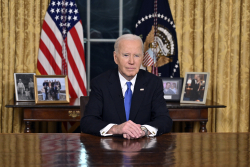Without that ceasefire, the subcontinent would likely have devolved into nuclear war sooner or later—a development that would have been catastrophic for the United States.
In the early hours of Saturday, news broke that the Trump administration had successfully negotiated a ceasefire between the warring powers of India and Pakistan. This was perceived as a sudden and somewhat shocking move by an American president, who only days earlier had insisted on his lack of interest in the longtime ethno-religious blood feud.
Yet Trump ultimately did get involved in stopping it. Why?
India and Pakistan Are Terrifyingly Close to Nuclear War
One of the problems was the way the war was going for India. The Pakistani military, long believed to be inferior to the Indian military, had a string of early victories at the start of the war that sent many observers reeling.
Armed with Chinese missiles, and with indirect and logistical support from Turkey, the Pakistani military managed to shoot down five Indian warplanes and to blunt the Indian assault into Pakistan. Thus, India was looking to escalate to the next level of conflict—under the belief that the Indians would dominate higher levels of warfare against their Pakistani neighbors.
Part of that escalation, however, risked uncontrolled escalation into nuclear conflict. There were concerns that the Indians were readying to strike not only vital economic hubs in Pakistan—notably the port city of Karachi—but that the Indian military was even considering targeting Pakistani nuclear weapons depots.
Had that occurred, it would have triggered a rush on the part of the Pakistanis to hit the nuclear weapon launch button before it was destroyed, rather than risk their already shaky nuclear weapons arsenal being decapitated by an Indian first strike.
India Struck Pakistani Nuclear Weapons Bases
Downplayed by Islamabad as a meaningless strike, India’s recent precision-guided munitions strike on Kirna Hills—where Pakistan maintains a substantial nuclear facility—betrays a dangerous war plan by New Delhi. Clearly, the lower-level war that India initiated in response to Pakistan’s unwillingness to cease its alleged support for Islamist terrorist groups like Lashkar-e-Taiba was not going the way Indian strategists had assumed it would. More importantly, Islamist-friendly Pakistan was clearly undeterred by the increasing threats from their Indian neighbors.
By launching the precision strikes at the Kirna Hills underground nuclear weapons storage facility in Pakistan, New Delhi was letting Pakistani leaders know that the true hammer was readying to fall. Multiple analysts have speculated that the Indians launched bunker-busting munitions at the Pakistani nuclear complex, indicating a desire to actually damage or even destroy the expansive underground facility.
The Indians, however, were stopped in their tracks by their devastating failure to achieve air superiority in the opening hours of the war. Thus, rather than remain fixated on destroying the suspected bases of Islamist militant groups in Pakistan, the Indian Air Force (IAF) began targeting key Pakistani military infrastructure. The Kirna Hills underground nuclear weapons storage facility was only one of the targets; the IAF also targeted Pakistan’s Nur Khan military base near the capital city of Islamabad.
Nur Khan was one of Pakistan’s largest military facilities, as well as a key element in the country’s already shaky nuclear weapons command-and-control infrastructure. By knocking that base out, the Indians might have precipitated a nuclear weapons strike from the Pakistanis, who might have concluded that the strikes on Nur Khan and the Kirna Hills were part of a larger strategy to knock out Pakistan’s nuclear weapons entirely—and acted accordingly.
It was at this point that the Trump administration intervened. Secretary of State Marco Rubio had been keeping the back channels open in the week leading into the inevitable war. But after the targeting of Pakistani nuclear weapons depots and bases by the IAF, Vice-President JD Vance spoke directly with Indian Prime Minister Narendra Modi, who was overseeing India’s “Operation Sindoor,” the overall attack on Pakistan. Immediately after that phone call, Modi, to the dismay of his military leadership, ordered an immediate cessation of hostilities.
The Pakistani leadership was all too happy to oblige the American ceasefire request. After all, despite initial successes against the Indians, most Pakistani leaders knew that if India really went up the escalation ladder, and if the conflict became a protracted one, Pakistan would likely not have been able to keep up. As things are now, Islamabad achieved what it wanted: its homegrown terror network struck India with impunity, and when New Delhi attempted to retaliate, it humiliated its air force. Things could scarcely be better.
The Ceasefire Averted a Major Disaster
This is the real story behind the ceasefire. Most people will never know how close we were to India and Pakistan going nuclear. And the ceasefire is quite porous, as reports suggest that both sides have ignored the ceasefire. Nevertheless, it is a necessary ceasefire.
Without that ceasefire, the subcontinent would likely have devolved into nuclear war sooner or later. And such a conflict would have probably triggered a much wider war, as both India’s and Pakistan’s larger allies rallied to their respective sides.
About the Author: Brandon J. Weichert
Brandon J. Weichert, a Senior National Security Editor at The National Interest as well as a contributor at Popular Mechanics, who consults regularly with various government institutions and private organizations on geopolitical issues. Weichert’s writings have appeared in multiple publications, including the Washington Times, National Review, The American Spectator, MSN, the Asia Times, and countless others. His books include Winning Space: How America Remains a Superpower, Biohacked: China’s Race to Control Life, and The Shadow War: Iran’s Quest for Supremacy. His newest book, A Disaster of Our Own Making: How the West Lost Ukraine is available for purchase wherever books are sold. He can be followed via Twitter @WeTheBrandon.
Image: Shutterstock / Joey Sussman.
















